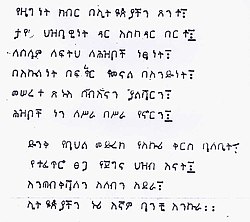Amharic language
Amharic (አማርኛ āmariññā) is a Semitic language spoken in North Central Ethiopia by the Amhara. It is the second most spoken Semitic language after Arabic, and the official language of Ethiopia. Amharic is also the official or working language of several of the states, including Amhara Region and the multi-ethnic Southern Nations, Nationalities, and People's Region.[3]Amharic has been spoken in Ethiopia since the late 12th century in various industries including the legal system, commerce, communications, the military and religion.[4]
| Amharic | ||||
|---|---|---|---|---|
| አማርኛ (Amarəñña) | ||||
| Pronunciation | [amarɨɲːa] | |||
| Native to | Ethiopia | |||
| Ethnicity | Amhara | |||
| Native speakers | 22,000,000[1][2] (2007 Population and Housing Census) | |||
| Language family | ||||
| Writing system | Ge'ez script (Amharic syllabary) Amharic Braille | |||
| Official status | ||||
| Official language in | ||||
| Regulated by | Imperial Academy (former) | |||
| Language codes | ||||
| ISO 639-1 | am | |||
| ISO 639-2 | amh | |||
| ISO 639-3 | amh | |||
| Linguasphere | 12-ACB-a | |||
| ||||
Also known as Amarigna, Amarinya, there are 25 million plus speakers of Amharic in various countries of the world, mainly in Ethiopia, & also in Eritrea.
Amharic uses a script which originated from the Ge'ez alphabet. It has 33 basic characters with each having 7 forms or variations for each consonant-vowel combination. Unlike the North Semitic languages such as Arabic, Hebrew or Syrian, the language is written from left to right.
Amharic is considered a Holy Language for the Rastafari religion, whose name itself comes from Amharic words Ras, literally signifying ‘head’, and having a similar meaning to the title ‘Duke’, and Täfäri, the name used by Haile Selassie I prior to his reign as Ethiopian regent and emperor until 1974. The religion uses Amharic in music and as a second language for many of its followers.[5]
Amharic Language Media
The Ethiopian anthem (since 1992) in Amharic, done on manual typewriter.
The vowels of Amharic on a vowel chart. Vowels in parentheses are allophones of /ɨ/ and /ə/.
The Ethiopic (or Geʽez) writing system is visible on the side of this Ethiopian Airlines Fokker 50: it reads "Ethiopia's": የኢትዮጵያ ye-ʾityop̣p̣ya.
A modern usage of Amharic: the label of a Coca-Cola bottle. The script reads ኮካ-ኮላ (koka-kola).
References
- ↑ Central Statistical Agency. 2010. "Population and Housing Census 2007 Report, National". Accessed 13 December 2016].
- ↑ Lewis, Lewis M.; Simons, Gary F.; Fennig, Charles D. (2015). Amharic Ethnologue: Languages of the World. SIL International. Retrieved 3 June 2017.
- ↑ "Amharic Language - Dialects & Structure - MustGo". MustGo.com. Retrieved 2021-06-22.
- ↑ Adugna, Gabe. "Research: Language Learning - Amharic: Home". library.bu.edu. Retrieved 2021-06-22.
- ↑ "Amharic in the Wider World". Ethiopia Online Visa. 2018-12-04. Archived from the original on 2021-06-24. Retrieved 2021-06-22.
| This language has its own Wikipedia project. See the Amharic language edition. |



